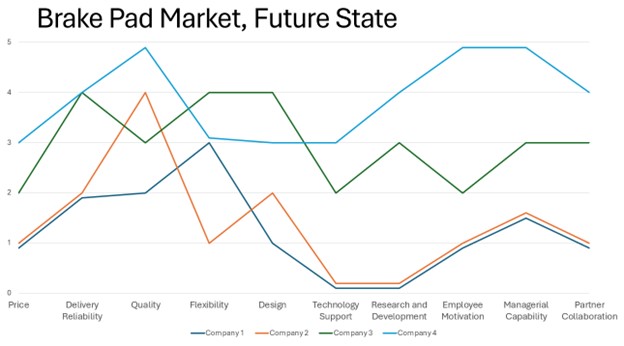Most organizations see this as an area they can improve but haven't developed effective processes for doing so. Here's one.

Last week I was reviewing the plans for the introduction of technology to reduce defects in a Canadian manufacturing company. The technology would identify defective items and enable the company to target and eliminate them.
The business case for the investment in the technology seemed impressive. Eliminating the defects would reduce costs, improving customer service and delivery on time. The company was taking valuable steps forward in its digital transformation and addressing an important weakness in its current operations. The implementation appeared well planned and I was confident that my contact, the manufacturing manager in the organisation, would manage it effectively.
However, the question the project provoked for me was, where does this project fit strategically in the organisation? It would require significant resources (financial and human) that would not be available for other possible projects and I wanted to understand how it was aligned with business strategy. I discussed this with the manufacturing manager and received assurances the project was an appropriate priority, based on the short payback period that she predicted.
Bringing business and technology together
Alignment of business and technology strategy has been a challenge for many years. I have participated in countless discussions on how the business and technology people in organisations can work better together, ensuring that technology investment decisions make the best use of scarce organisational resources. Most organisations see this as an area where they can do better but have not developed effective processes and practices for doing so.
This was difficult and critical before the Fourth Industrial Revolution and it’s much harder and more critical today. The Fourth Industrial Revolution is an era of rapid organisational change, largely driven by advances in information technology. In the past, slow change meant that strategy in organisations changed slowly and technology investments were usually smaller and less strategically critical. Today, most projects are more strategically important, larger and existential. Selecting the projects that will have the best strategic impact is critical.
I have previously written about digital transformation strategy development using SWOT analysis. I emphasised the strategy process should be collaborative, bringing together business and technical people, using SWOT in the way that it was originally intended. A further tool will help you hone your strategy further.
The business strategy canvas
Chan Kim and Renee Mauborgne, professors at INSEAD, an international business school based in France, developed the concept of Blue Ocean Strategy. This approach centers on competing through new products and services, processes, business models and customers that are so substantially different that you no longer have competition – moving away from the intense competition of a ‘red ocean’ (a competitive analogy based on sharks turning the water red by attacking their prey).
Their tool, the Business Strategy Canvas, can be used to help develop your digital transformation strategy. It helps you consider how information technology may be applied in a Blue Ocean way, by focusing on the factors that you will compete on in the future.
The following example introduces this tool. The automotive industry is changing quickly. Model changes are more frequent, electric vehicle sales are growing, technologies in cars that support the driver are developing quickly and the number of car producers is growing. Producers are asking for closer relationships with suppliers to support frequently changing product design, lower costs, quality improvement and delivery reliability. Component suppliers see the demands of the producers change quickly and are considering their digital transformation strategy.
The Business Strategy Canvas is used to understand your competitive factors and those of your main competitors so your future strategy can be planned. In the following chart, the current competitive factors for the main companies that supply brake pads, in the automotive industry, are plotted and we can see the competitive strategies that have been adopted by each company.
The canvas has the competitive factors along the bottom and their level on the left. The level of each competitive factor for each company is plotted in the canvas. There are four main companies in this fictitious brake pad market. The first focuses on a very low-cost strategy while the second prioritises low cost but also focuses on achieving a higher level of quality. The third emphasises being able to supply a wide range of vehicles while the fourth has a unique, patented design that is recognised to create higher quality brake pads. The other factors plotted here also vary in the emphasis that is given to them by the four companies.

After the completion of the current state canvas, the future state can be considered. While the desires of the brake pad customers are changing, the technologies available to the manufacturers are too. Their strategy development integrates understanding of customer needs, the technologies available to the manufacturers and how they may be applied, and any knowledge that is available of the strategies being adopted by competitors. The future state Business Strategy Canvas includes the larger number of competitive factors that are now important in the brake pad market.
The business strategy that will be adopted will need to combine knowledge from across the organisation. This will be enabled by the use of the canvas, involving business, technology, human factors specialists and others. It should be completed collaboratively in a meeting or series of meetings. It is important to emphasise that the wider range of competitive factors that exists makes it even more important that a wide range of people participate in this process.
The future strategies that were adopted in this fictitious market are reflected in the chart below which will determine the companies’ technological change that should be pursued. We can see that different companies have adopted different approaches and that these have changed the competitive market significantly, leading to very different technology strategies. Some may focus on reducing costs with automation, while others will focus on flexibility, quality and collaboration. If technology adoption is not aligned with the business strategy, the value it provides is likely to be less and it may undermine future competitive capability.

The Business Strategy Canvas should be revisited regularly as required and amended as customer desires change, technology advances and competitors respond.
The canvas focuses attention on the application of information technology in radical ways in organisations, that will maximise the competitive benefits. In an organisation that is usually changing very slowly, the information technology-based changes considered are often small scale, with lower cost, less disruption and lower risk.
The opportunities available through the application of technology are often much bigger, but they require higher levels of investment and risk. They also require highly competent change leadership. The Business Strategy Canvas helps you develop the radical possibilities for your organisation. You may still choose a more conservative approach to your digital transformation but you should do so having properly understood the range of possibilities open to you—and your competitors.



